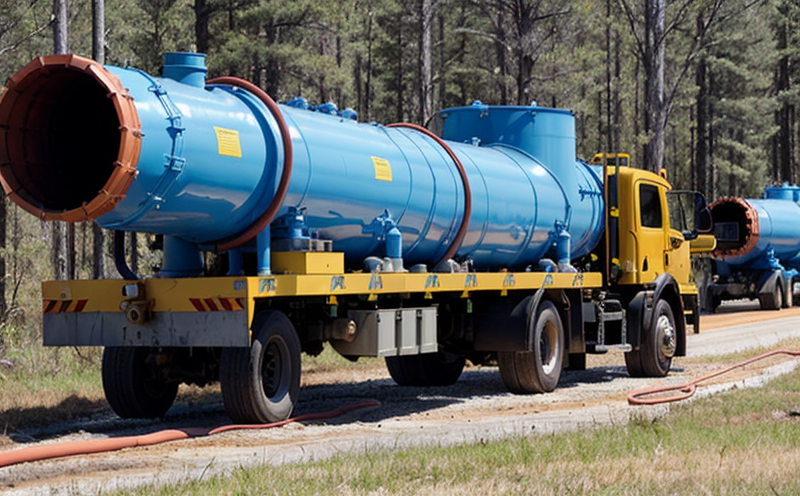ASTM D3359 Adhesion Testing of Pipeline Coatings
The ASTM D3359 adhesion test is a critical procedure used in the power and utilities sector, specifically for ensuring the integrity of pipeline coatings. This test evaluates the bond strength between the coating material and the substrate (typically steel) to ensure it can withstand the harsh environmental conditions that pipelines face during operation.
The primary purpose of this test is to determine whether the protective coating adheres sufficiently well to prevent corrosion from penetrating the base metal. The test method is widely recognized in the industry, with standards such as ASTM D3359-21 being the latest revision. This ensures that the testing procedure remains current and relevant to the changing demands of pipeline construction and maintenance.
The adhesion test can be conducted on various types of coatings used in natural gas distribution pipelines, including polyethylene (PE), epoxy, and coal-tar enamel. The test is particularly important for ensuring that the coating has sufficient adhesion strength to provide a barrier against corrosive elements such as water, oxygen, and soil.
The test procedure involves several steps. First, a sample of the pipeline coating is prepared by cutting a section from the pipe. This sample is then mounted on a fixture in a manner that simulates real-world conditions. A small adhesive strip is applied to this sample, and after it has dried or cured according to specified times, it is removed carefully. The adhesion strength is then measured using a tensile testing machine.
The results of the test are reported based on the percentage of the coating that remains adhered to the substrate. A higher percentage indicates better adhesion performance. This information is crucial for quality managers and compliance officers as it helps them ensure that the pipeline coatings meet industry standards and can effectively protect the pipelines from corrosion.
The ASTM D3359 test is not only a regulatory requirement but also an essential part of the quality control process in the design, procurement, and construction phases of natural gas distribution projects. It ensures that materials used are of high quality and capable of providing long-term protection to the infrastructure.
Understanding the context within which this test operates helps stakeholders appreciate its importance. In the power and utilities sector, pipeline integrity is paramount due to the potential risks associated with leaks or failures in transport systems. The adhesion properties of coatings play a significant role in preventing these risks by ensuring that the coating remains intact even under the harshest conditions.
By adhering strictly to ASTM D3359, laboratories can provide reliable and consistent results that are recognized globally. This ensures that the testing process is standardized across different regions, which is essential for maintaining high-quality standards in the industry.
Benefits
The implementation of ASTM D3359 adhesion testing offers several key benefits to various stakeholders involved in pipeline integrity and safety. For quality managers, this test ensures that only materials with sufficient adhesion properties are used in construction projects. This reduces the risk of coating failures over time, which can lead to costly repairs or replacements.
Compliance officers benefit from ASTM D3359 by ensuring that all testing procedures meet international standards. This helps them stay abreast of regulatory requirements and ensures that their organizations comply with legal mandates related to pipeline safety and maintenance.
R&D engineers find the test particularly useful for developing new coating materials or improving existing ones. By conducting ASTM D3359 tests, they can evaluate how different factors such as temperature, humidity, and substrate type affect adhesion strength.
For procurement specialists, this test provides a reliable method to assess the quality of coatings being sourced from suppliers. It ensures that only high-quality materials are procured for use in pipeline projects, thereby enhancing overall project performance and safety.
In summary, ASTM D3359 adhesion testing is an essential tool in maintaining pipeline integrity and ensuring compliance with international standards. Its benefits extend across various roles within the industry, from quality assurance to regulatory compliance, making it a cornerstone of pipeline safety practices.
International Acceptance and Recognition
- ISO 1461:2005 – This international standard for coating adhesion testing is closely aligned with ASTM D3359, providing additional context to the global acceptance of this test method.
- EN ISO 1461:2005 – European standards that complement ASTM D3359 and are widely recognized across Europe for their rigorous quality control measures.
- ASTM D3359-21 – The latest revision of the standard, ensuring it remains up-to-date with industry practices and technological advancements.
- IEC 60488:2017 – International Electrotechnical Commission standards that provide additional guidance for testing adhesion properties in various industrial applications, including pipelines.
The ASTM D3359 adhesion test is widely accepted and recognized internationally. Its consistency with other international standards ensures that the results are comparable across different regions and organizations. This global acceptance enhances confidence in the quality of pipeline coatings used worldwide.





